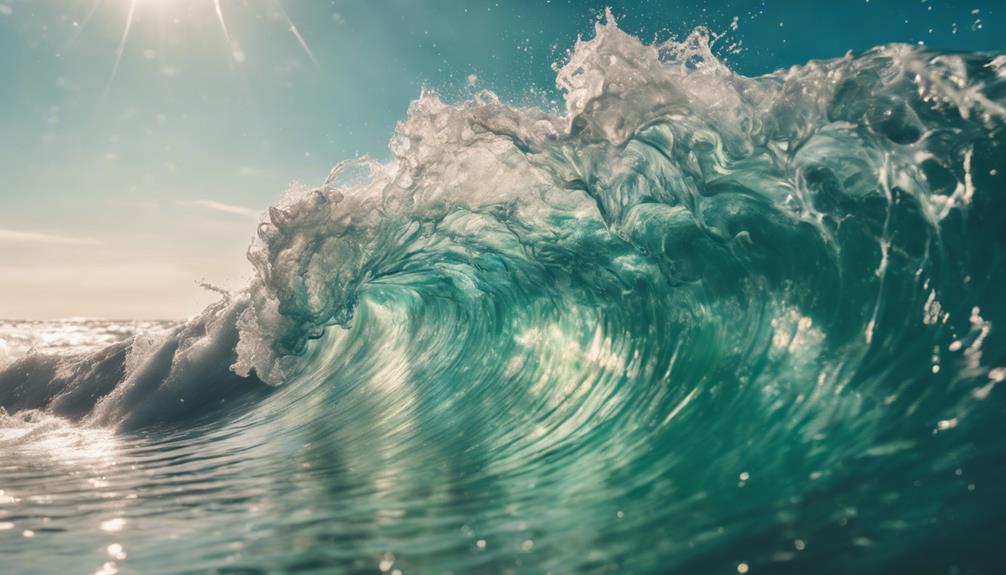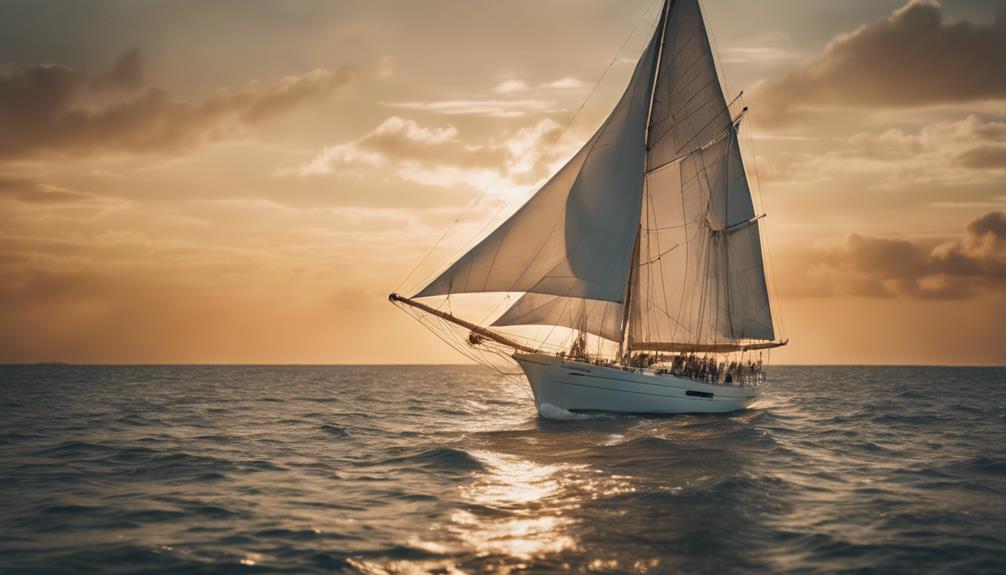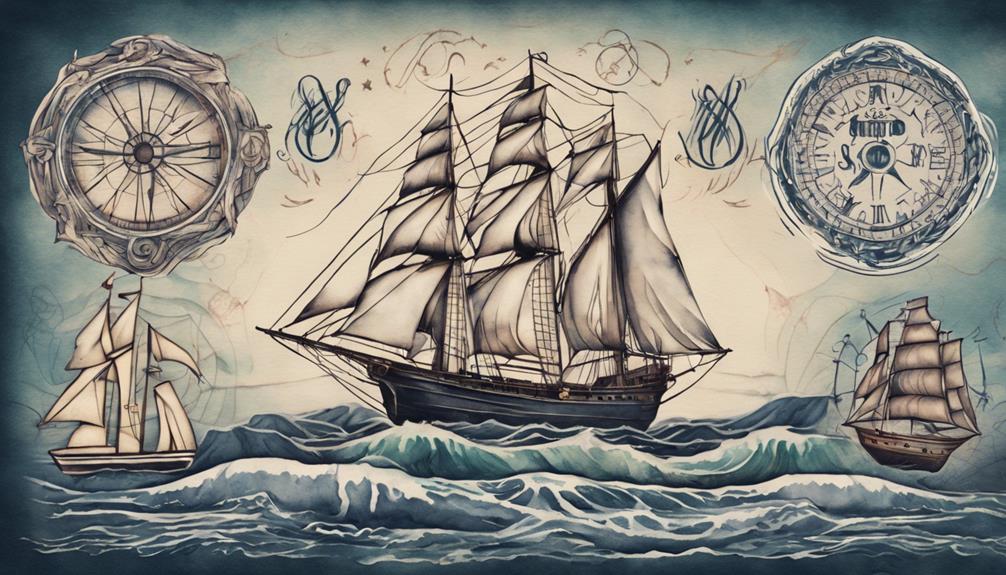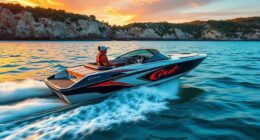The fastest sailboat in the world is Sailrocket 2, reaching a jaw-dropping speed of 65.45 knots. This modern marvel showcases the incredible advancements in sailing technology, utilizing hydrofoils to lift out of the water and reduce drag. Meanwhile, classic vessels like the Cutty Sark highlight the rich history of sailing achievements. Innovations in design and materials, like carbon fiber, have transformed how sailboats perform. As engineers continue to push boundaries, future vessels aim to exceed even these remarkable speeds. You'll discover more about the challenges and breakthroughs that drive this exhilarating pursuit.
Key Takeaways
- The fastest traditional sailing ship, built by Donald McKay, achieved a record speed of 22 knots (41 km/h) in the 19th century.
- Sailrocket 2 set the modern sailing speed record at 65.45 knots, revolutionizing speed in sailing technology.
- Syroco became the first vessel to exceed 100 km/h, utilizing innovative hydrofoil and kite propulsion.
- Advanced materials and engineering techniques continue to enhance the performance and speed of modern sailboats.
Historical Context of Fast Sailboats
Exploring the historical context of fast sailboats reveals how innovations in design and technology have shaped maritime speed records over the years.
Take, for instance, the clipper ship built by Donald McKay in 1854. This remarkable vessel achieved a world record speed of 22 knots (41 km/h) and made headlines with its historic 82-day passage from Honolulu to New York City. This journey wasn't just significant for its speed; it showcased the clipper's potential in maritime trade, which was essential during that era.
Behind the scenes, advancements in shipbuilding techniques and materials were already underway. The clipper not only excelled in speed but also broke the record for the transatlantic route to Liverpool, completing the journey in just 13 days and 12 hours.
Fast forward to the late 20th and early 21st centuries, and you'll see how modern crafts like Sailrocket 2 have pushed the boundaries even further, reaching speeds of 65.45 knots.
These historical records not only highlight the pursuit of speed but also reflect the ongoing evolution of sailing technology, setting the stage for future record-breaking achievements.
Record-Breaking Sailing Achievements

Record-breaking sailing achievements showcase the relentless pursuit of speed and innovation in maritime history, with each new milestone pushing the boundaries further. Throughout the years, sailors have faced the biggest challenge of mastering the elements while maximizing their vessels' potential.
Here are some remarkable records that have held the record for excellence:
- Fastest traditional sailing ship: Built by Donald McKay in 1854, it reached an impressive 22 knots (41 km/h).
- Transatlantic record: The same ship completed the journey from New York City to Liverpool in just 13 days and 12 hours.
- Honolulu to New York: This vessel showcased its capabilities by finishing the passage in a mere 82 days.
- Modern speed records: Sailrocket 2 revolutionized sailing speed, achieving an average speed of 65.45 knots, proving that innovation can propel the whole boat beyond traditional limits.
These achievements highlight not just the technology behind the vessels, but the spirit of adventure that drives sailors to push the envelope in pursuit of speed on the open seas.
Notable Fast Sailboats and Features

When you explore notable fast sailboats, you'll discover a mix of historic records and cutting-edge engineering.
The *Sailrocket 2* and *Syroco* showcase how innovation drives speed on water, while classics like the *Cutty Sark* remind us of the rich history behind sailing achievements.
These vessels not only represent speed but also highlight remarkable advancements in design and technology.
Historic Speed Records
Throughout maritime history, several notable fast sailboats have set astonishing speed records that continue to inspire sailors and enthusiasts alike.
One of the most remarkable is the clipper ship built by Donald McKay in 1854. This incredible vessel achieved a speed of 22 knots (41 km/h) and set several historic records that still impress today.
Here are some of its notable achievements:
- 82 Days: This clipper sailed from Honolulu to New York City in just 82 days.
- Transatlantic Record: It completed the journey to Liverpool in 13 days and 12 hours.
- 24-Hour Distance: The ship was the first to cover over 400 nautical miles (740 km) in a single 24-hour period.
- Legacy: While its records were groundbreaking for traditional sailboats, modern sailing technology has since surpassed them.
These achievements showcase the exceptional sailing performance of this clipper, a demonstration of the evolution of maritime engineering.
Rights reserved to honor the legacy of these historic vessels, reminding us that the spirit of competition on the seas continues to thrive.
Engineering Breakthroughs
Engineering breakthroughs in sailing have revolutionized the design and performance of fast sailboats, making them faster, safer, and more stable than ever before.
Take, for example, Sailrocket 2, which set the record for the fastest sailing speed at an incredible 65.45 knots in 2012, thanks to innovative hydrofoil technology. Similarly, Syroco made history by becoming the first vessel to exceed 100 km/h on water, utilizing a unique hydrofoil paired with a kite for propulsion.
Projects like SP80 aim even higher, targeting speeds over 80 knots through advanced hydrofoil designs and super-ventilating surface piercing foils. Modern materials such as carbon fiber enhance these vessels' speed capabilities, while aerodynamic designs contribute greatly to their performance compared to historical ships.
These engineering feats emphasize not just raw speed but also stability and safety. Features like automatic balance adjustments and super-cavitation techniques help keep these high-speed vessels stable on the water.
As you explore these advancements, you'll appreciate how they continue to push the boundaries of sailing, transforming it into a thrilling race against time.
Engineering Innovations in Sailing Design

Modern sailing designs have transformed dramatically, thanks to advancements like hydrofoils and lightweight materials that push the boundaries of speed and efficiency.
These innovations are revolutionizing how you think about sailing, enabling vessels to reach unprecedented speeds while maintaining stability and control.
Here are some key engineering innovations that stand out:
- Hydrofoils: Craft like the Syroco use hydrofoil designs to lift the hull above water, drastically reducing drag and achieving speeds over 100 km/h.
- Super-Ventilating Foils: The SP80 project features surface piercing foils that enhance speed and stability through advanced fluid dynamics, making sailing smoother and faster.
- Automatic Control Systems: Sailrocket 2 showcases automatic release mechanisms that improve performance, allowing for better handling in various conditions.
- Lightweight Materials: Using composites and carbon fiber reduces weight, boosting overall efficiency and speed without sacrificing strength.
These innovations not only enhance the performance of modern sailboats but also make the sailing experience more exhilarating and accessible for everyone.
With each new design, the future of sailing looks brighter and faster than ever.
Challenges Faced by Record Challengers

Record challengers face numerous obstacles that test their designs and skills as they push the limits of sailing speed. Teams like Syroco and SP80 grapple with significant engineering challenges, especially in maintaining stability at high speeds. Super-cavitation techniques require precise control to avoid air disruptions around the foil, which can make or break a record attempt.
You need to optimize your designs for hydrofoil efficiency and kite alignment to generate sufficient drive while minimizing drag. This demands constant adjustments based on varying water conditions. Safety measures are non-negotiable, as high speeds elevate accident risks; Sailrocket, for instance, incorporates a Kevlar cockpit and advanced exit mechanisms for emergencies.
Beyond the technical hurdles, there's also the psychological pressure of live recordings and an audience watching your every move. Strong team dynamics and thorough preparation become essential to combat this stress.
Additionally, environmental factors like wind and water conditions can drastically impact performance, forcing you to adapt your strategies in real-time during attempts. Each of these challenges tests your resolve and ingenuity, pushing the boundaries of what's possible in sailing speed.
Technology in Modern Sailing

Innovative technology has revolutionized sailing, enabling boats to achieve unprecedented speeds through advanced designs and materials. Today's high-performance sailboats are equipped with cutting-edge features that enhance speed and efficiency on the water. Here are some key advancements you should know about:
- Hydrofoils: These allow sailboats to lift above the water, drastically reducing drag and increasing speed. Designs from Syroco and SP80 exemplify this innovation.
- Advanced Materials: The use of carbon fiber and lightweight composites in construction not only boosts speed but also improves overall efficiency during races.
- Automation: Modern sailboats now integrate automation and mechanical power modules, which adjust balance automatically. This lets you focus on optimizing both speed and direction.
- Kite Technology: Emerging as a game changer, kite technology generates immense drive force. Projects like SP80 aim to exceed 80 knots, showcasing this potential.
With these advancements, sailing has transformed into a high-tech sport, pushing the limits of what's possible on the water.
Embracing these technologies can be the key to achieving record-breaking speeds and staying at the forefront of modern sailing.
The Human Element in Sailing

When you step onto a sailboat, your mental resilience becomes just as important as the technology around you.
The way you communicate and collaborate with your team can make or break your performance, especially under pressure.
Consider how each member's determination contributes to your shared goal of achieving new speed records.
Mental Resilience in Sailing
Mental resilience plays a vital role in sailing, as it helps you navigate the intense pressure of high-speed challenges and maintain focus amid the chaos. When you're racing against the clock, psychological readiness is just as important as your physical skills.
Here are four key aspects of mental resilience that can enhance your sailing experience:
- Confidence: Trusting your abilities allows you to make quick, effective decisions under pressure, especially during record attempts.
- Determination: Staying committed to your goals helps you push through obstacles and setbacks, keeping the team motivated.
- Mental Preparation: Developing strategies to cope with psychological stress, like performing in front of live audiences, is essential for maintaining focus.
- Community Support: Engaging with fellow sailors and learning from their experiences fosters a supportive environment that enhances your own mental strength.
Team Dynamics and Collaboration
Effective team dynamics are essential in sailing, as every crew member's collaboration directly influences the boat's performance and speed during high-stakes races. You'll find that each role on the crew is important; without seamless coordination, executing maneuvers efficiently becomes nearly impossible.
In these moments, psychological preparedness plays a key role. You need to cultivate confidence and mental resilience to manage the intense pressures of live recordings and audience expectations during record attempts.
Moreover, collaboration extends beyond just the sailors. Teams like Syroco and SP80 actively engage with engineers specializing in aerodynamics and hydrodynamics to fine-tune designs, which boosts overall sailing performance. A shared vision and enthusiasm among crew members foster motivation and camaraderie, especially when past record holders recognize current challengers.
Effective communication is essential during races and trials. You must maintain clarity about each person's responsibilities to stay focused and optimize performance under challenging conditions.
When you align your efforts and communicate openly, you enhance not only the boat's speed but also the entire team's morale, making each race a reflection of your collective dedication and skill.
Future of High-Speed Sailing

The future of high-speed sailing is set to take off as innovative teams like Syroco and SP80 push the boundaries of speed and sustainability on the water. You'll witness breathtaking advancements that promise to change the game forever. Here's what you can expect:
- Speed Targets: Syroco aims to exceed 100 km/h (62 mph) using cutting-edge hydrofoil designs and kites, while SP80 targets over 80 knots (92 mph) through advanced engineering.
- Sustainable Practices: Both teams emphasize eco-friendly materials and efficient propulsion systems, ensuring that high-speed sailing minimizes environmental impact.
- Advanced Techniques: Super-cavitation techniques in Syroco's design dramatically reduce drag, and SP80's mechanical power module enhances stability with automatic balance adjustments.
- Collaborative Innovations: Ongoing partnerships among experts in aerodynamics and hydrodynamics are fueling breakthroughs that push the limits of sailing performance.
These exciting developments not only promise thrilling speeds but also highlight a shift toward sustainability in sailing.
As you follow these projects, you'll see how the future of high-speed sailing isn't just about going faster—it's about doing so responsibly.
Frequently Asked Questions
What Is the Fastest Sail Boat in the World?
You might be surprised to learn that the fastest sailing vessel is Sailrocket 2, which reached an incredible average speed of 65.45 knots in 2012, setting a remarkable benchmark for future sailing records.
What Is the Fastest Sailing Ship Ever?
The fastest sailing ship ever is the *Clipper Ship Flying Cloud*. You'd be amazed it reached 22 knots in 1854, completing remarkable journeys from Honolulu to New York in just 82 days.
What's the Fastest Ship Ever Built?
You might think modern vessels are unbeatable, but the *Flying Cloud* remains the fastest ship ever built, reaching 22 knots. Its impressive records from the 19th century still resonate, showcasing extraordinary maritime engineering of its time.
What Is the Fastest Sea Going Vessel?
The fastest sea-going vessel is the Sailrocket 2, which set a record at 65.45 knots. Its innovative hydrofoil design revolutionized sailing, showing how technology can push boundaries and achieve incredible speeds on water.
What Makes the Fastest Sail Boat in the World Different from the Fastest Sailboat Ever?
The fastest sailboat ever: unleashing speed was designed with cutting-edge materials and streamlined features, allowing it to reach unprecedented velocities. In contrast, the fastest sailboat in the world focuses on maneuverability and agility, making it ideal for competitive racing in various wind conditions.
Conclusion
In the thrilling world of fast sailboats, you're not just witnessing speed; you're experiencing the very essence of maritime evolution.
Each record shattered is a demonstration of human ingenuity and determination.
As you dream of gliding over the waves like a lightning bolt, remember that the future holds even more astonishing breakthroughs.
So, buckle up, because the next generation of sailing is poised to release speeds that'll make your head spin and redefine what it means to conquer the seas!










